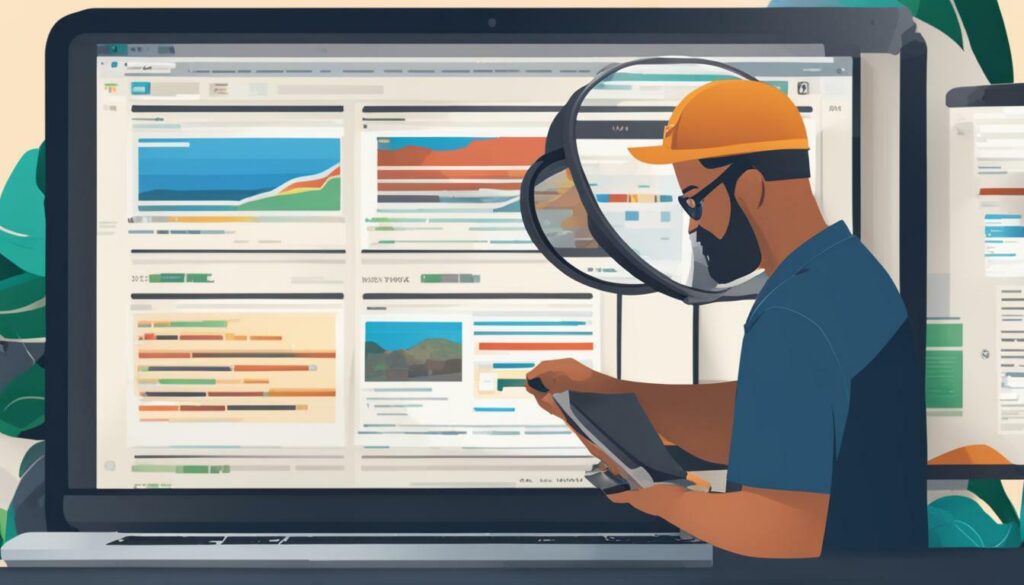Scan WordPress website for vulnerabilities and ensuring its ideal functionality is crucial for maintaining its security and protecting it from cyber threats.
Regular testing allows you to experiment with design elements without disrupting your live site and helps you identify issues that could impact user experience.
There are three common types of testing: functionality testing, performance and speed testing, and security testing.
You can set up a staging site or create a local environment to test your website privately.
Tools like Sucuri, Wordfence, and IsItWP Security Scanner can help you scan your website for potential security vulnerabilities.
Once you have identified the vulnerabilities, you can take appropriate steps to fix them, such as updating plugins and themes, changing passwords, and modifying server configurations.
Regularly scan your WordPress site for vulnerabilities and following best practices for testing ensures its ideal functionality and helps protect it from potential threats.
The Importance of Regular Testing
Regular testing allows you to experiment with design elements without disrupting your live site and helps you identify issues that could impact user experience. It is crucial for ensuring the ideal functionality of your WordPress website and maintaining its security. By regularly testing your website, you can proactively address any vulnerabilities or weaknesses before they are exploited by cyber threats.
There are three common types of testing that you should consider for your WordPress website: functionality testing, performance and speed testing, and security testing. Functionality testing ensures that all features and functionalities of your website are working correctly. It involves checking buttons, forms, links, and other interactive elements to ensure they are functioning as intended.
Performance and speed testing focuses on optimizing the loading speed of your website. It involves analyzing factors that could affect the speed, such as image sizes, caching mechanisms, and server response times. By conducting performance testing, you can enhance the user experience by providing a fast and smooth browsing experience.
Security testing is essential for identifying vulnerabilities that could potentially compromise the security of your website. It involves scanning your website for potential security weaknesses, such as outdated plugins or weak passwords. By regularly conducting security testing, you can stay ahead of potential threats and take proactive measures to protect your WordPress website.
The Importance of Scan WordPress Website
Regular testing not only helps you maintain the ideal functionality of your WordPress website, but it also provides you with the opportunity to experiment with design elements without impacting your live site. By setting up a staging site or creating a local environment, you can make changes and test new features without affecting the user experience.
Tools like Sucuri, Wordfence, and IsItWP Security Scanner can assist you in scanning your WordPress website for potential vulnerabilities. These tools help identify potential security weaknesses and provide recommendations to strengthen your website’s security. It is recommended to use a combination of these tools to ensure comprehensive scanning and analysis of your website.
Once you have identified vulnerabilities through the scanning process, it is important to take prompt action to fix them. This may involve updating plugins and themes to their latest versions, changing passwords to stronger ones, and modifying server configurations to enhance security. Regularly scanning your WordPress site for vulnerabilities, following best practices for testing, and promptly addressing identified issues will help ensure the ideal functionality and security of your website.

| Type of Testing | Description |
|---|---|
| Functionality Testing | Checks if all features and functionalities of your website are working as intended |
| Performance and Speed Testing | Optimizes the loading speed of your website by analyzing factors that could affect speed |
| Security Testing | Identifies potential vulnerabilities and weaknesses that could compromise the security of your website |
Tools to Scan WordPress Websites
Tools like Sucuri, Wordfence, and IsItWP Security Scanner can help you scan your website for potential security vulnerabilities. These tools are designed to analyze your WordPress website and detect any weaknesses that could be exploited by hackers or malware. By regularly scanning your website with these tools, you can identify vulnerabilities and take appropriate actions to fix them before they become a security risk.
Sucuri is a popular website security scanner that offers a comprehensive suite of security features. It can scan your WordPress website for malware, monitor file changes, and provide real-time alerts for potential security threats. Sucuri also offers a website firewall that helps protect your site from malicious attacks.
Wordfence is another powerful security tool that includes a vulnerability scanner for WordPress websites. It scans your site for known vulnerabilities in plugins, themes, and the WordPress core. Wordfence also provides a firewall and a range of other security features to help protect your site from attacks.
IsItWP Security Scanner is a free plugin that allows you to scan your WordPress website for potential security vulnerabilities. It checks your site for common security issues and provides recommendations on how to fix them. IsItWP Security Scanner is easy to use and can be a valuable tool for improving the security of your WordPress website.
| Tool | Features |
|---|---|
| Sucuri | Website security scanner, malware scanning, file change monitoring, real-time alerts, website firewall |
| Wordfence | Vulnerability scanner, firewall, security features |
| IsItWP Security Scanner | Free plugin, vulnerability scanning, security recommendations |
By utilizing these tools, you can ensure the security and integrity of your WordPress website. Regular scanning and proactive vulnerability checks are essential in protecting your site from potential threats. Incorporating these tools into your website management routine will help you stay one step ahead of hackers and ensure the ideal functionality of your WordPress site.
Fixing Identified Vulnerabilities
Once you have identified the vulnerabilities in your WordPress website, it is important to take immediate action to address them and ensure the security of your site. There are several steps you can take to fix the identified vulnerabilities and protect your website from potential threats.
The first step is to update your plugins and themes. Outdated or vulnerable plugins and themes can provide an entry point for hackers to exploit. By regularly updating them to the latest versions, you close any security loopholes and ensure that your website is running on secure and stable software.
Another critical step is to change your passwords. Strong, unique passwords are essential for safeguarding your website. Make sure to update the passwords for your WordPress admin account, FTP account, and any other privileged accounts associated with your website. Additionally, consider implementing two-factor authentication for an added layer of security.
Modifying server configurations is another important measure to fix vulnerabilities. This includes implementing secure protocols such as HTTPS, enabling a Web Application Firewall (WAF), and configuring access control rules to restrict unauthorized access to your website’s files and directories.
| Steps to Fix Identified Vulnerabilities: |
|---|
| 1. Update plugins and themes |
| 2. Change passwords |
| 3. Modify server configurations |
Best Practices for Fixing Vulnerabilities
- Regularly scan your website for vulnerabilities using tools like Sucuri, Wordfence, and IsItWP Security Scanner.
- Keep your plugins and themes updated to the latest versions.
- Implement strong and unique passwords for all accounts associated with your website.
- Consider enabling two-factor authentication for added security.
- Configure secure server protocols and implement a Web Application Firewall (WAF).

By following these steps and best practices, you can ensure that your WordPress website is secure and functioning optimally. Remember, maintaining the security of your website is an ongoing process, so it is important to regularly scan for vulnerabilities and take appropriate actions to fix them.
Best Practices for Testing WordPress Websites
Regularly scanning your WordPress site for vulnerabilities and following best practices for testing ensures its ideal functionality and helps protect it from potential threats. There are several key steps you can take to optimize your testing process and safeguard your website.
Conduct Regular Scans
Performing regular scans using a reliable WordPress vulnerability scanner is essential for identifying any potential security vulnerabilities. These scans should be conducted on a scheduled basis to ensure that any new vulnerabilities are promptly detected. By staying ahead of potential threats, you can take the necessary steps to safeguard your site and prevent any unauthorized access or data breaches.
Keep Plugins and Themes Updated
Outdated plugins and themes can leave your website vulnerable to attacks. It is crucial to regularly update all plugins and themes to their latest versions to ensure that any security patches or bug fixes are implemented. This will help close any potential security loopholes and maintain the security and efficiency of your website.
Follow Security Recommendations
Implementing security recommendations provided by reputable sources is another crucial aspect of testing your WordPress website. Stay informed about the latest security practices and guidelines and apply them to your website. This may include using strong passwords, enabling two-factor authentication, limiting login attempts, and implementing SSL certificates for secure data transmission.
By incorporating these best practices into your testing routine, you can minimize the risk of security breaches and ensure the smooth functioning of your WordPress website.
| Best Practices for Testing WordPress Websites |
|---|
| Conduct regular scans using a reliable WordPress vulnerability scanner |
| Keep plugins and themes updated to their latest versions |
| Follow security recommendations provided by reputable sources |
Regularly scanning your WordPress site for vulnerabilities and following best practices for testing ensures its ideal functionality and helps protect it from potential threats.

Setting Up a Staging Site or Local Environment
You can set up a staging site or create a local environment to test your website privately. This allows you to experiment with design elements, plugins, and themes without disrupting your live site. Testing in a staging environment ensures that any changes or updates you make won’t affect the functionality or security of your website.
To set up a staging site, you can use plugins like WP Staging or WP Stagecoach, which create a clone of your live site. These plugins make it easy to create a separate environment where you can test new features, design changes, or updates. You can also use a local development tool like XAMPP or MAMP to create a local server environment on your computer.
Once you have your staging site or local environment set up, you can make changes and test them without impacting your live site. This allows you to identify any issues, such as compatibility problems or conflicts between plugins, before implementing them on your live site. It also provides a safe space to test security measures and perform vulnerability checks.

Benefits of a Staging Site or Local Environment
Having a staging site or local environment offers several advantages. Firstly, it allows you to experiment and make changes without the risk of breaking your live site. This is especially important when testing new plugins or code snippets, as it prevents potential conflicts or errors from impacting your visitors.
Secondly, a staging site or local environment provides a controlled testing environment. You can run security scans, perform vulnerability checks, and test different security measures without exposing your live site to potential threats. This ensures that your WordPress website remains secure and protected.
Lastly, a staging site or local environment offers a collaborative space for team members or clients to review and provide feedback on proposed changes or updates. This facilitates effective communication and streamlines the development process, leading to more efficient website management.
| Benefits of a Staging Site or Local Environment: |
|---|
| Safe testing environment without impacting live site |
| Prevents potential conflicts or errors |
| Controlled environment for security checks |
| Collaborative space for team feedback |
Conclusion
Regularly scanning your WordPress website for vulnerabilities and ensuring its ideal functionality is crucial for maintaining its security and protecting it from cyber threats. With the ever-evolving landscape of online security, it’s essential to stay proactive in identifying potential risks that could compromise your website’s integrity.
There are three common types of testing that can help you ensure the optimal performance of your WordPress site. Functionality testing allows you to experiment with design elements and plugins without disrupting your live site. Performance and speed testing help you identify any bottlenecks or issues that may slow down your website, negatively impacting user experience. Security testing is crucial in identifying vulnerabilities and potential entry points for hackers.
Setting up a staging site or creating a local environment for testing is highly recommended. This allows you to perform tests in a private environment, away from the public eye. By doing so, you can make changes, test new features, and troubleshoot issues without affecting your live website.
Utilizing tools like Sucuri, Wordfence, and IsItWP Security Scanner can greatly assist you in scanning your WordPress website for potential security vulnerabilities. These tools provide comprehensive scanning capabilities, allowing you to identify any weak points that may be exploited by malicious actors.
Once you have identified vulnerabilities in your WordPress website, it is crucial to take prompt action to fix them. This may involve updating plugins and themes, changing passwords, and modifying server configurations. By addressing these vulnerabilities promptly, you can minimize the risk of a security breach and preserve your website’s integrity.
Regularly scanning your WordPress website for vulnerabilities and following best practices for testing ensures its ideal functionality and helps protect it from potential threats. By staying proactive and vigilant, you can maintain a secure and reliable website for your users.
